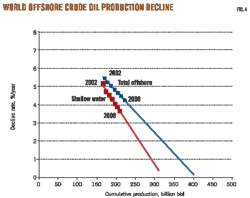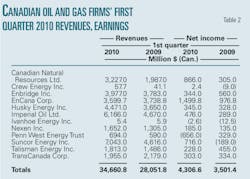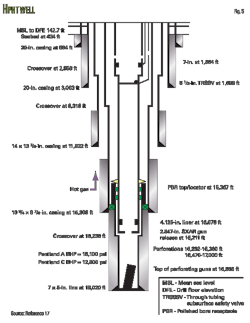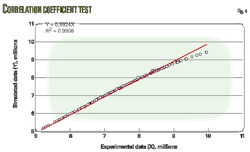Improved ultrasonic (UT) inspection methods address storage tank integrity monitoring and assessment without removing tanks from service. By acquiring large amounts of high-density UT data and evaluating them with readily available analysis tools, inspectors can now provide tank owners and regulators with insight into the integrity of above-ground storage tank (AST) floors not otherwise available.
Electronic advances over the past 5 years have improved floor inspection of ASTs by in-service robotic technology, yielding not only better inspection and tank cleaning abilities, but greater operational efficiency and a broader user base. The number of tanks inspected with in-service robotics now exceeds 1,000. Inspections can now occur without the tank being taken out of service.
Compliant with API Std 653 (Ref 1) guidelines for determining tank floor corrosion rates and when combined with an API 653 tank external survey, TechCorr, Houston, uses in-service robotics with high-density ultrasound scanning to give tank owners a full picture of AST condition without removing the tank from service and while staying in compliance with tank inspection requirements.
Some tanks require out-of-service inspections because of their condition, age, and inspection history, but a growing population of tanks will benefit from this technology, especially given current demand for storage capacity and difficulty in removing a tank from service for full inspection.
This article discusses specific technical capabilities for use of in-service, high density, ultrasound scanning to assess the condition of AST floors. It will also cover safety, environmental risk reduction, and cost savings.
Conventional inspections
Conventional tank inspection requires an operator to clear the tank completely of product and vapor. Product drains first through fixed lines and then temporary lines to remove most of the volume. Squeegees, diesel diluent, and water frequently serve as means for removing residual product. Fans, sometimes in conjunction with vapor-recovery burning equipment, occasionally enter service to remove tank vapors. Once the tank is vapor free, its floor is prepared for inspection, often by sand blasting.
A variety of techniques including magnetic flux exclusion (MFE) and contact ultrasound testing (UT) inspect the tank. Crews then make any necessary repairs, reseal the tank manways, and return the tank to service. The entire process may take 1 week to 6 months depending on tank size, product, plant and contractor schedules, and scope of repairs.
Robotic inspections
The robotic process for tank inspection uses a robot tethered via an umbilical to an advanced control and monitoring system. The robot (Fig. 1) descends to the tank bottom while the tank is in service and navigates across its floor using a system capable of mapping locations where high-density UT data are collected. Robot location accuracy is ±2 in. A pump mounted behind the robot removes water and sediment from the tank floor, and a series of immersion transducers under the robot take UT thickness readings on the tank floor to identify both top-side and bottom-side corrosion.
An in-service AST robotic floor scanner can remove water and sediment from the tank floor to take thickness readings and gauge corrosion (Fig. 1).
Inspectors can at the same time conduct a traditional API 653 external tank survey and combine the results in an inspection report satisfying API 653 guidelines. Any repair work can be scheduled in the future and competitively bid to reduce repair expenses and plant disruption. The benefits of the robotic process include:
- Reduced project planning. Keeping the tank in service during inspection eliminates scheduling difficulties. Planning also requires fewer internal resources and contractors since the project is simpler.
- Reduced safety, environmental risks. Keeping product in the tank removes the need to vapor-free it or place personnel inside it.
- Deferred tank repairs. Delaying repairs until the optimal year allows reduction of costs and disruption.
- Maximized asset lifecycle. Establishing a database on the lifecycle and reliability of the floor allows for more frequent monitoring than is practical with conventional process.
The accompanying table compares and contrasts the two tank inspection strategies.
Deployment methodology
Typical robot deployment necessitates finding the equipment control room and associated utilities adjacent to the tank within the berm area. The deployment process usually requires one or two crane lifts to the top of the tank. Equipment at the top of the tank consists of the submersible vehicle and umbilical, pumping systems, and in-tank deployment gear. The vehicle enters through the roof’s top manway (≤24-in. diameter). A 350-ft (107-m) umbilical supports vehicle operation.
While readying the system for deployment from the top of the tank, the crew locates tank navigation transducers at their proper locations around the tank, entering these locations, as well as the position of all other tank appurtenances, into a computer-assisted drafting (CAD) system.
A video recording by the on-board camera during deployment ensures proper positioning onto the tank bottom. Accurate drawings are sometimes unavailable, requiring special procedures to accurately plot various objects—roof supports, inlet and discharge pipes, sumps, and related internals—within the tank. Once the CAD drawing is properly annotated and the vehicle properly positioned, the vehicle is ready for floor scanning. A camera deployed through the manway records the condition of roof structures and degree of corrosion, if present.
UT methodology
Before recent improvements, a typical UT run consisted of capturing data from all eight transducers every 0.16 in. (0.4 cm) while the vehicle travelled in a straight path for 6.56 m, providing roughly 1,200 A scans, converted into B scans for each individual run. Data were collected, analyzed, and reported. New ultrasonic systems use real-time data streaming for continuous UT thickness surveying throughout the tank rather than simply by performing one run on each plate. A standard tank plate now may get 6,000 to 10,000 readings.
The robotic floor scanner typically uses eight 5-Mhz transducers for tank inspections, making 6,000-10,000 readings per tank plate (Fig. 2).
Fig. 2 shows an in-service robotic immersion transducer. Most tank inspections use eight 5-megahertz (Mhz) transducers.
Inspection of a typical 100-ft diameter tank floor would yield an ultrasonic testing data distribution similar to the one pictured here (Fig. 3).
Fig. 3 shows the distribution of UT data in a typical 100-ft tank without obstructions (other than legs, inlet, and suction lines). Thickness measurements are loaded into a spreadsheet that checks the B scan data limits. Proprietary signal processing software highlights any location with a measured thickness less than a predetermined value, which are then reviewed by an analyst. This review determines the cause of the low thickness measurement. Causes could include actual component thinning, gate error, loss of signal, sludge-sediment, or the vehicle running over a weld seam.
This technique can acquire a wide range of UT data points, usually between 50,000 and 1.5 million UT readings/tank, depending on tank size and inspection strategy. These readings, taken throughout the tank, include the critical zone around the shell.
This data analyst interface shows both A-scan and B-scan data, providing a histogram to show metal loss found as part of a particular run (Fig. 4).
Manually reviewing this volume of data is not practical. Fig. 4 is the data analyst display providing the automated results of UT A-Scan—B-Scan analysis. An analyst can investigate minimum thickness thresholds detected by UT analysis software.
UT, EVA
Although 100% robotic inspection is possible in principle, it may be neither economical nor necessary. Most inspections measure thickness over a fraction of the floor and then estimate minimum floor thickness using extreme value analysis (EVA). This technique, used throughout the inspection industry, often is applied for inspection of pipelines, on which 100% coverage is impractical and unnecessary. Some tank owners also use EVA statistics when they evaluate out-of-service floor UT data following MFL scans.
In-service inspections seek to establish an acceptable time interval for the next internal floor inspection. Meeting this requires obtaining an accurate assessment of the deepest pitting. EVA statistics can make this estimate from inspection of only a small percent of the tank floor area and is widely used in many applications of corrosion monitoring. Using EVAs requires a number of assumptions, a discussion beyond the scope of this paper.2 3
Presuming the inspection plan meets requirements for application of EVA, data need to be collected from only a small percentage of the tank floor. Results of field tests and more than 20 independently monitored validation studies demonstrate that a small population sample of the tank floor can provide satisfactory results.4
The proper amount of tank scanning depends on the nature and amount of corrosion. The tank operator will consider these factors as well as risk tolerance when selecting the amount of scanning. For example, a quick preliminary robotic survey could determine the amount of coverage desired. Such surveys give a good qualitative indication of the general condition of the tank floor. Completing data analysis while the robot is still in the tank can identify and accommodate areas where supplementary data would be useful.
Defect identification
On stream inspections also seek to identify a range of plate defects in addition to plate thickness. Although a lack of sufficient clarity usually prohibits direct visual examination, topside and bottom-side corrosion can be indirectly classified, laminated plate identified, and coating failure detected.
Topside, bottom-side
Examining the series of returns before and after the flagged return can discriminate topside from bottom-side corrosion. When the front face, the first discernable return from the plate, remains steady on the x-axes (time) while the second discernable return on the time axes moves toward the first return, the thinning is most likely due to bottom-side pitting. On the other hand, if the front return moves along the x-axes toward a fixed second return, then the thinning is probably due to topside pitting.
Measuring the distance between any two discernable peaks always determines the degree of thinning. Signal analysis software assists in classification. Noticeable dips on the top of the B scan UT display or gaps on the underside of the B-scan display show areas of possible topside or bottom-side pitting, respectively.
Lamination
Laminations are usually defects inherent in tank floor steel, created during fabrication. They usually appear mid-wall and are characterized as UT A scan returns measuring 50% of total peak-to-peak distance of the nominal plate. These mid-wall defects usually prove difficult to detect with qualitative scanning techniques but can be identified with high-density UT by the monitoring of abrupt changes from near nominal peak-to-peak values to values close to 50% of nominal.
Laminated areas can occupy anything from small plate areas (i.e., a few sq cm) to large plate areas (i.e., 1 sq m). Lamination is common but in most cases does not pose any serious tank-floor integrity threat unless found at a weld or in the critical zone adjacent to the shell-to-floor weld.
Coating failure
Unless the tank’s contents allow for direct inspection of a surface via camera, the UT analyst must depend on knowledge of UT to detect separation between the steel and the coating. Coatings in this instance refer to a direct layer of epoxy or a thick material liner (such as fiberglass resin). When a coating failure occurs, UT returns (pulse-echo modes) are scattered, making thickness measurements impossible. Pockets of air or gas occupying the space between the lifted coating (or liner) and the steel floor usually cause these returns. When detected adjacent to plate characterized by clear UT returns, however, with sufficient signal-to-noise ratios for peak-to-peak measurements, they likely reflect areas of coating failure.
Fig. 5 shows an A-Scan image of coating failure.
This analyst display shows the A-scan UT image of a coating failure. UT scanning is required unless the tank environment is clear enough to allow direct visual inspection (Fig. 5).
Life calculations
The in-service inspection seeks to establish parameters quantitatively to set the next internal inspection. Documents such as API 653 typically use bottom condition, corrosion rate, and thinnest remaining steel as governing parameters. Robotic in-service inspection provides these data. Inspection and statistical data analysis also provide minimum remaining metal estimates, with the corrosion rate computed from this information.
The tank operator can also use inspection data to estimate how much longer the tank can remain in service before a bottom leak. Some codes and regulations may specify a non-zero minimum remaining bottom metal thickness for operations. The operator can use in-service data to make an informed, quantitative decision regarding the appropriate schedule for out-of-service inspection and repair. In-service floor UT data also improve the effectiveness of risk-based inspection programs.
The industry uses RBI programs to focus resources on important components in process facilities. An RBI analysis assesses both the probability and consequences of failure. Results can prioritize inspections within a plant and select appropriate inspection methods for the most probable modes of failure.
The important feature of RBI analysis as it relates to UT scanning of tank floors is the added level of confidence available for determining degrees of risk using accurate, quantifiable UT floor-thickness data, removing some of the ambiguity previously associated with risk-based assessments. Indirect, risk-based assessments of tank floor conditions can now be verified and augmented with reliable direct measurements.
Fig. 6 shows results of a 35-tank analysis, including RBI results with and without high-density tank floor UT data. The results support the benefits of using actual floor UT data in risk-based studies to improve forecasting of the appropriate next internal inspection interval.
Robotic cleaning
Cleaning ASTs conventionally typically requires a great deal of manpower, equipment, and time out of service. In-service robotics reduce manpower and equipment requirements and eliminate time out of service. The robotic system can use a variety of pumps to pump sludge and sediment into awaiting containers for disposal. Depending on the sediment level, inspection can occur during cleaning, eliminating the equipment needed for an out-of-service cleaning.
Economic effect
In addition to safety and environmental benefits, in-service tank inspections offer cost benefits compared with out-of-service methods. Out-of-service inspections have difficulty controlling both visible and hidden costs.
Visible costs consist of payments directly to contractors for cleaning, inspecting, waste disposal, and repair. Indirect, hidden costs, however, usually dwarf direct expenses. Traditional inspection methods require extensive planning by the operator and multiple contractors before scheduling, typically pulling time from internal resources involved in engineering, supply, scheduling, safety, and tank operations.
Product and vapor freeing the tank also has hidden costs. Owners frequently incur costs for transferring and downgrading product in preparation for cleaning, sometimes building temporary lines to move product from the tank. Tank-heel disposition often also results in hidden costs, as otherwise saleable product becomes intermingled with water and sludge.
Once a tank is out of service, the operator may also incur supply-related costs associated with downtime: higher shipping costs for smaller inbound lots, transportation costs for two-porting ships or rerouting trucks, and production effects due to reduced storage capacity.
At most companies the full cost of tank cleaning and inspection spans multiple cost centers and there is no one person who accounts for all of the costs associated with the entire process for even one tank. For example, engineers know the cost of inspecting the tank, but only traders know the costs of securing an alternative source of product. And while the operator is aware of incremental trucking costs incurred while the tank is down, only the engineer knows the true incremental cost for emergency versus competitively bid tank repairs.
Fig. 7 depicts the total system cost associated with the tank cleaning, inspection, and repair process. The industry standard process of opening, cleaning, and inspecting an AST is at times followed by hurried repairs to the AST. Repairing an AST on an emergency basis when it is already out-of-service is expensive and operationally disruptive to the facility.
Waiving the standard bidding process is typical to avoid lengthy out-of-service time for the tank. At the same time, vendors charge a premium to complete the work as quickly as possible. In addition to paying a premium for tank repair, most tank owners conduct tank repair work years before it is required to prevent taking the tank out of service again. Many repairs are also done earlier than warranted so that they can be completed while the tank is out of service, forcing the operator to accelerate deferrable costs into the current budget cycle.
In-service inspections allow tank operators to avoid emergency repairs during API 653 inspection by determining the scope of repairs before removing the tank from service and competitively bidding the work and ordering of required materials
By waiting until the optimal time for tank repairs, the operator also extends the asset’s useful life and defers associated capital or expense dollars into a future year.
Sludge measurement
The acoustic inspection system measures the volume and topology of sludge sediments in the bottom of liquid storage tanks.
The system includes an ATEX inspection tool inserted into the tank through a suitable access hole in the roof until fully submerged in the liquid. The end of the tool has an angled phased array producing acoustic beams to scan a sector of the tank floor and wall (Fig. 8).
PC-based data acquisition produces a three-dimensional display of the sediment layer and calculates the volume of sediment using the known geometry of the tank. Sector data from multiple entry points can be combined to give 100% coverage of the tank floor.
References
- American Petroleum Institute Standard 653, Tank Inspection, Repair, Alteration, and Reconstruction, December 1998.
- “Introduction To Life Prediction of Industrial Plant Materials: Application of the Extreme Value Analysis Statistical Method for Corrosion Analysis,” editor Kowaka, M., Allerton Press, 1994.
- Galambos, J., “The Asymptotic Theory of Extreme Order Statistics,” New York: John Wiley & Sons, 1978.
- Silverman, E., Bass, R., Furillo, F., and Wolf, A., “In-Service Oil Tank Cleaning and Inspection System: Results of Eight (8) Independent Validations,” ASNT Proceedings, Fall Conference, pp. 87-95, November 2000.
The authors













